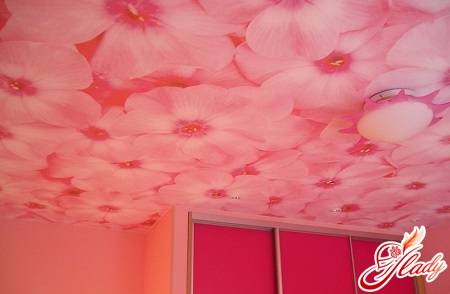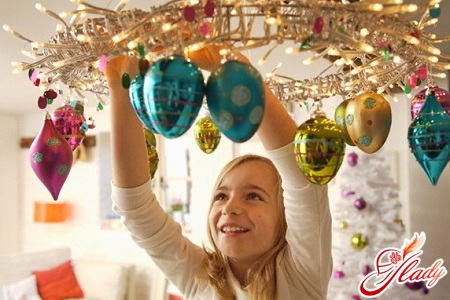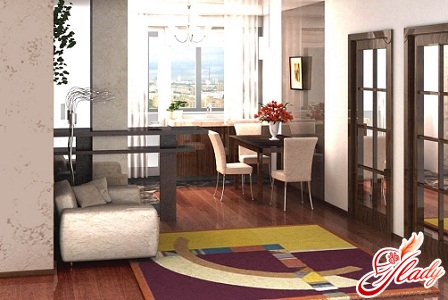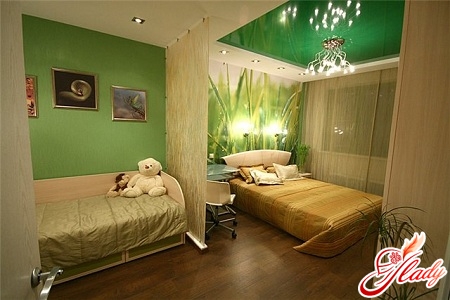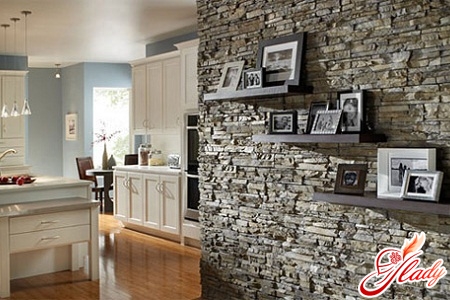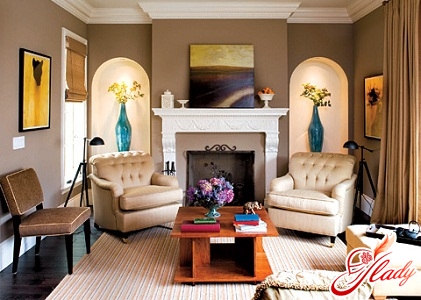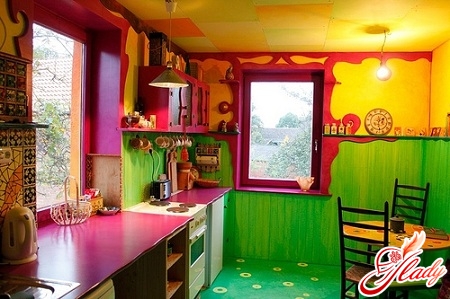 The fact that color largely determines ourmood and state of mind, no one will argue anymore - this is a well-known truth. However, it turns out that not only mood, but also the perception of the surrounding space can be color-dependent. That is precisely why designers and psychologists attach such importance to color in the interior of the home. There are universal rules for combining colors that “work” in any living space, and there are also designer recommendations for the color scheme of each specific room in the house. For example, what should be the color combination in the kitchen interior? What to use and what colors to choose for finishing the walls and floor, what furniture to buy and what color to choose for accessories? What color combination for the kitchen is considered classic, what is fashionable today, and what advice from designers should be taken into account when choosing a color scheme for this room? Let's figure it out.
The fact that color largely determines ourmood and state of mind, no one will argue anymore - this is a well-known truth. However, it turns out that not only mood, but also the perception of the surrounding space can be color-dependent. That is precisely why designers and psychologists attach such importance to color in the interior of the home. There are universal rules for combining colors that “work” in any living space, and there are also designer recommendations for the color scheme of each specific room in the house. For example, what should be the color combination in the kitchen interior? What to use and what colors to choose for finishing the walls and floor, what furniture to buy and what color to choose for accessories? What color combination for the kitchen is considered classic, what is fashionable today, and what advice from designers should be taken into account when choosing a color scheme for this room? Let's figure it out.
Basic rules
When deciding on a color (or several colors) for your kitchen interior, there are two key points to remember.
When developing color schemes, designersuse a color wheel. It's like in music - different melodies are created from seven notes. In the same way, countless color palettes and color combination options in interior design are born from seven primary colors. The chromatic interior of the kitchen can be multi-colored or monochrome (single-color). Multi-color interiors, in turn, are divided into analogous (combination of adjacent colors), complementary (combination of contrasting colors), triad (combination of three colors). Let's take a closer look at these combinations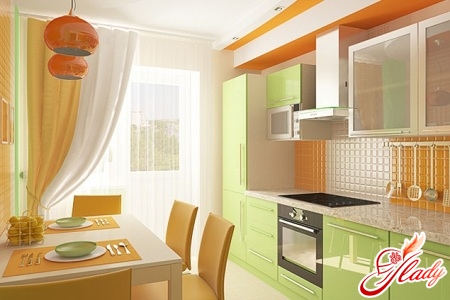
One-color kitchen
If you intend to design your kitchen in this stylemonochrome version, then you need to not only choose one base color, but also use its shades in the design. Designers believe that the more shades of one color are used in the monochrome design of the kitchen, the more interesting the interior will be. Another version of a monochrome kitchen is a combination of the base color and its shades with white. Another option (less popular, but no less interesting) is to use silver instead of white. And if white in a monochrome interior can be called a traditional choice, then the use of silver meets the latest fashion trends in interior design. You should be more careful when diluting the base color with black, which is also acceptable in a monochrome kitchen interior solution. However, black in combination with any other color (except white) is more likely to make the kitchen interior contrasting than monochrome. To prevent a monochrome kitchen from turning out monotonous and boring, designers recommend adhering to certain rules.
- Subordination. Professionals advise choosing at least three additional shades, one of which must be dominant.
- Zoning. Use different shades of the base color to divide the kitchen into functional areas. This method, to all the rest, allows you to correct the shortcomings of the layout.
- Use of different invoices. One color on materials of different texture looks different. Therefore, in the monochrome interior design of the kitchen, it is desirable to combine different textures: smooth wallpaper and decorative plaster, ceramics and wood, glossy and frosted glass.
- Contrast accents. Even one object that contrasts with the basic color of the shade kitchen will make the monochrome interior more "alive". For this, the already mentioned black color, and any bright shade, will do. Remember that the best is the enemy of the good, so do not oversaturate the interior of the kitchen with separate bright details.
Analogous color scheme for the kitchen
If you remember what a color wheel looks like(a schematic representation of the spectrum), you will be able to understand what analogous colors are. These are the colors that are located in the spectrum next to each other. Please note that we are not talking about shades of the same color, but about different colors. By the way, with such a combination of colors in the kitchen interior, you can use two or even more colors. For example, yellow in the spectrum is adjacent to orange and green, and green is located next to blue. Therefore, all four colors can easily be used to decorate the kitchen: orange, yellow, green and blue. But only one color (green or yellow) should still be dominant. Another option for using adjacent colors is two basic colors and complementary shades of the transition from one color to another. For example, yellow, green and light green; yellow, red and orange; red, purple and pink; pink, blue and lilac. Do not forget about the saturation of colors, giving preference to adjacent colors of the same brightness.
Contrasting cuisine
Using contrasting color combinations inkitchen interior, you need to be extremely careful. Because in this case, you risk making the kitchen overly aggressive or gaudy. A complementary scheme is based on a combination of colors opposite in the spectrum, where only one of the selected colors is also the main one. A contrasting kitchen, of course, looks stylish and fashionable. However, such an interior can soon become boring or even irritating. Therefore, with this version of the combination of colors in the kitchen interior, contrast is best achieved with easily replaceable accessories or finishing materials. Agree that curtains are easier to change than furniture, and wallpaper on the walls than flooring. An important rule of a contrasting color scheme is the already mentioned subordination. Only in this case, it concerns the main components of the kitchen interior: furniture, floor and walls. Furniture is the starting point. It should be darker than the walls and lighter than the floor. The most popular color combinations for the interior of a kitchen decorated in a complementary scheme:
- orange and blue;
- yellow and purple,
- peach and blue;
- pink and salad.
In addition, a combination of any bright color with white or black is considered contrasting.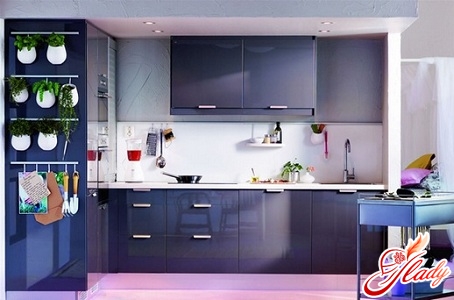
Three-color kitchen
The three-color kitchen design technique is rareis used by non-professional designers. But professionals skillfully play with such a combination of colors. The triad scheme is based on the combination of three colors located at the same distance from each other in the color wheel. But here too there is an unshakable rule: only one color can (and should) be the main one. If you risk using such a design technique, then remember the color combinations for it:
- green - purple - orange;
- yellow - blue - red;
- lilac - peach - salad;
- blue - pink - lemon.
Achromatic kitchen
Achromatic design is very popular today.This is the color scheme used when decorating a kitchen in Scandinavian style, high-tech, Provence or minimalism. The most striking example of achromatic design is a white kitchen. Options for achromatic kitchen design:
- black and white interior;
- Silver and black metallic in combination with white;
- white, diluted with brown, olive or terracotta;
- white and beige.
The main thing is that in pursuit of fashion your kitchen does notbegan to resemble a hospital ward or a factory laboratory. Therefore, the achromatic kitchen interior is more suitable for a country house, where the monotony or even the absence of color is more than compensated by the view from the window.
Summary
Whatever design option you choose, whatever color combination you choose for your kitchen interior, stick to the basic rules.
- The color of furniture should be darker than the color of the walls and lighter the color of the floor.
- White or black color without risk can be combined with almost any other color.
- In the multi-colored interior of the kitchen, use no more than five shades and no more than three colors.
- The main (dominant) color for any combination should be only one.
- Glossy surfaces enhance the depth and color saturation, matte mute.
- All the decorative elements of the kitchen play the role of color accents, so they should be the brightest.
As the design wisdom goes, there are incompatiblecolors do not exist. Therefore, the combination of colors in the kitchen interior depends, first of all, on your taste preferences. So try and experiment. In the end, this is your home, and you are the one who will live in it. Good luck We recommend reading:




